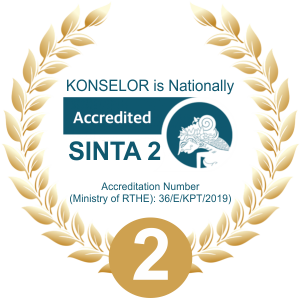Interaksi Sosial Siswa Berprestasi dalam Belajar
 ), Syahniar Syahniar(2),
), Syahniar Syahniar(2), (1) Universitas Negeri Padang
(2) Universitas Negeri Padang
 Corresponding Author
Corresponding Author
Copyright (c) 2017 Peni Ramanda, Syahniar Syahniar
DOI : https://doi.org/10.24036/02017627564-0-00
Full Text:
 Language : en
Language : en
Abstract
Keywords
References
Ardi, Z., & Yendi, F. M. (2013). Konseling Online: Sebuah Pendekatan Teknologi Dalam Pelayanan Konseling. Jurnal Konseling dan Pendidikan, 1(1), 1-5.
Ardi, Z. (2014). Cita-cita Perkerjaan dan Pilihan Peminatan Siswa Sekolah Menengah Atas Negeri di Sumatera Barat.
Bimo Walgito. 1999. Psikologi Sosial (Suatu Pengantar). Yogyakarta: Andi.
Bimo Walgito. 2010 Psikologi Kelompok.Yogyakarta:Andi.
Dian Wisnu Wardhani dan Sri Fatmawati M. 2012. Hubungan Interpersonal. Jakarta: Salemba Humanika.
Elida Prayitno. 2006. Psikologi Perkembangan Remaja. Padang: Angkasa Raya.
M.Budyatna dan Leila MG. 2011. Teori Komunikasi Antar Pribadi. Jakarta: Kencana.
Mohammad Ali dan Mohammad Asrori. 2010. Psikologi Remaja Perkembangan Peserta Didik. Jakarta: Bumi Aksara.
Ngalim Purwanto. 1992. Psikologi Pendidikan. Bandung: PT Remaja Rosdakarya.
Prayitno. 2004. Buku Seri Layanan 1-9 Bimbingan Konseling. Padang: BK FIP UNP.
Kirsch, I., Braun, H., Yamamoto, K., & Sum, A. (2007). America's Perfect Storm: Three Forces Changing Our Nation's Future. Educational Testing Service.
Dalton, R. J. (2005). The social transformation of trust in government. International Review of Sociology, 15(1), 133-154.
Carnoy, M., & Rhoten, D. (2002). What does globalization mean for educational change? A comparative approach. Comparative education review, 46(1), 1-9.
Gainau, M. B. (2009). Keterbukaan diri (self disclosure) siswa dalam perspektif budaya dan implikasinya bagi konseling. Jurnal Ilmiah Widya Warta, 33(1), 95-112.
Mustafa, H. (2011). Perilaku Manusia Dalam Perspektif Psikologi Sosial. Jurnal Administrasi Bisnis, 7(2).
Prayascitta, P. (2010). Hubungan antara coping stress dan dukungan sosial dengan motivasi belajar remaja yang orangtuanya bercerai (Doctoral dissertation, Universitas Sebelas Maret Surakarta).
Muharrifah, A. (2009). Interaksi Antara Remaja, Ayah, Dan Sekolah Serta Hubungannya Dengan Tingkat Stres Dalam Menghadapi Ujian Nasional (Doctoral dissertation).
Bunu, H. Y. (2012). Masalah Anak Taman Kanak-Kanak Menurut Guru dan Orang Tua serta Implementasiya dalam Bimbingan dan Konseling. Jurnal Bimbingan Konseling, 1(2).
Anni, C. T. (2012). Need Assesment Model Penyusunan Program Bimbingan dan Konseling Bidang Bimbingan Belajar Berbantuan Sistem Informasi Manajemen di Sma Negeri Kota Semarang. Educational Management, 1(1).
Dinartiwi, A. (2011). Persepsi siswa tenyang layanan bimbingan dan konseling di SMK Grafisika Yayasan Lektur Jakarta Selatan.
Lestari, S. D. (2013). Hubungan Dukungan Keluarga dengan Harga diri Penderita Kusta Rawat Jalan di Rumah Sakit Rehatta Donorojo Jepara. Karya Ilmiah S. 1 Ilmu Keperawatan.
Ari, W. P. (2013). Tinjauan Kriminologis terhadap Kenakalan Remaja (Juvenile Delinquency) (Doctoral dissertation).
Cavana, R. Y., Delahaye, B. L., & Sekaran, U. (2001). Applied business research: Qualitative and quantitative methods. John Wiley & Sons Australia.
Morgan, D. L. (2007). Paradigms lost and pragmatism regained methodological implications of combining qualitative and quantitative methods. Journal of mixed methods research, 1(1), 48-76.
Stone, H., Sidel, J. L., & Bloomquist, J. (2008). Quantitative descriptive analysis. Descriptive Sensory Analysis in Practice, 53-69.
Welch, M. (2000). Descriptive analysis of team teaching in two elementary classrooms: A formative experimental approach. Remedial and Special Education, 21(6), 366-376.
 Article Metrics
Article Metrics
 Abstract Views : 1129 times
Abstract Views : 1129 times
 PDF Downloaded : 425 times
PDF Downloaded : 425 times
Refbacks
- There are currently no refbacks.
Copyright (c) 2017 Peni Ramanda, Syahniar Syahniar

This work is licensed under a Creative Commons Attribution 4.0 International License.







